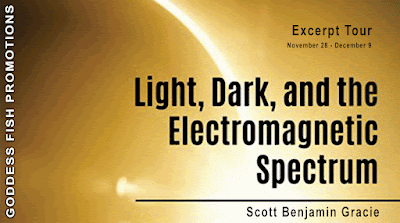This post is part of a virtual book tour organized by Goddess Fish Promotions. Scott Benjamin Gracie will be awarding a $15 Amazon or B/N GC to a randomly drawn winner via rafflecopter during the tour. Click on the tour banner to see the other stops on the tour.
Since the dawn of time, electromagnetic energy has permeated through the universe, surrounding and interacting with everything it touches, illuminating, destroying and giving life.
The colourful section of the electromagnetic spectrum we see in the form of visible light, rainbows and other phenomena is tiny when compared to its vast entirety. Using many parts of the electromagnetic spectrum have become common everyday occurrence for the majority of people on Earth, as it's been integrated into our lives in ways that we don't even think twice about it.
This book illuminates many parts of the electromagnetic spectrum and its effects, the endless ways we have harnessed its energy, and how we interact and live with its influence.
Astronomy – Studying the Universe Through Light Capturing Light with Telescopes Astronomy is a field where the objects of study cannot be physically touched. Except for very close objects such as the Moon, light coming from the object being viewed is the only way we have to gain data. Not only do we use visible light to observe and find out more information, but we also have specialised equipment that can detect other parts of the electromagnetic spectrum such as radio waves, microwaves, infrared, ultraviolet, X-rays and gamma rays. With all these different data points, scientists can build a portfolio about the speed, physical composition and even type of object they are observing. Certain chemicals emit radiation at very specific wavelengths or colours called emission lines. Scientists use this method to study the chemical makeup of objects in the universe. Through this method, we can determine the elements that the object is made up of without even being close to the object or having it in a lab to study. Light gives us insight into what would have otherwise been unknown. Infrared Astronomy Infrared has many applications within the field of astronomy. It can be used to look through dark interstellar dust clouds to reveal hidden stars and other objects. The different types of infrared – near, mid and far – all have their applications when being used to investigate the universe, although many scientists consider near infrared to not be part of infrared astronomy. Using infrared can better reveal low-mass red dwarfs and even large red giant stars that are too faint in the visible light spectrum. Mid-infrared will better reveal cooler objects such as comets, asteroids and planets. Planets radiate heat they have absorbed from the Sun or from internal heat. Dust that lies in the plane of our solar system as well as dust around other stars that is warmed by sunlight is also very prominent in mid-infrared. Far infrared allows astronomers to see very cold matter, such as huge clouds of gas where new stars are starting to form. Ultraviolet Astronomy Scientists use the various wavelengths of UV light for a different perspective of the objects they are viewing by revealing otherwise hidden aspects of the object. However, Earth-based viewing of astronomical objects in ultraviolet is difficult because the Earth’s atmosphere blocks most UV radiation. Therefore, these types of observations are best made from outside the atmosphere by putting special instruments in space. Using these instruments, scientists can study what was previously unseen or it can enhance what is already visible.
Scott's passion for light and the electromagnetic spectrum began in his early teens while tinkering with electronics as a hobby. He was formally introduced to the lighting industry while studying Electrical and Electronics in Sydney, Australia, and in 1998 he started his career making custom light fittings and lamps in his dad's garage. Formal lighting design qualifications expanded his opportunity to help project-manage and design on many industry levels.
Twenty-two years on, and Scott has worked on many major infrastructure, commercial and architectural lighting projects. He is a member of the Illuminating Engineering Society of Australia & New Zealand, the Colour Society of Australia, the International Dark Sky Association and the Astronomical Society of the Pacific.
WEBSITE https://www.lightdarkeverything.com.au/
GOODREADS https://www.goodreads.com/author/show/22364418.Scott_Benjamin_Gracie
LINKEDIN https://www.linkedin.com/in/lightingprofessional/
Get a copy of Light, Dark and the Electromagnetic Spectrum
AMAZON.COM https://amazon.com/dp/0228849969
AMAZON.COM.AU https://amazon.com.au/dp/0228849969
KINDLE https://amazon.com/dp/B09XQ13DN3
INDIGO CHAPTERS https://www.chapters.indigo.ca/en-ca/books/light-dark-and-the-electromagnetic/9780228849964-item.html
BARNES & NOBLE https://www.barnesandnoble.com/w/light-dark-and-the-electromagnetic-spectrum-scott-benjamin-gracie/1141351186
BOOK DEPOSITORY https://www.bookdepository.com/Light-Dark-and-the-Electromagnetic-Spectrum-Scott-Benjamin-Gracie/9780228849964
BOOKTOPIA https://www.booktopia.com.au/search.ep?keywords=9780228849964
a Rafflecopter giveaway



Thanks for hosting!
ReplyDeleteLight, Dark, and the Electromagnetic Spectrum sounds like an interesting read for me as I am a huge science geek. Thank you for sharing your bio and book details
ReplyDeleteThis sounds like an interesting book.
ReplyDelete